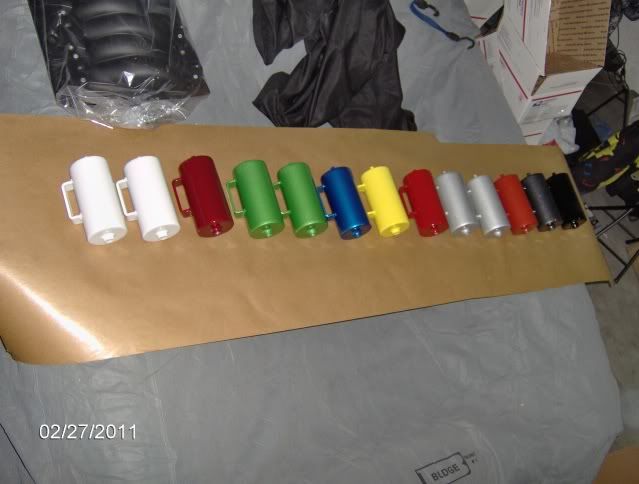Understanding the need for a oil separating catchcan:
#1
Understanding the need for
a proper PCV oil separating catchcan
Any engine driven hard will ingest a certain amount of oil into the intake air system resulting in loss of power, detonation, and long term carbon buildup on the pistons & valves reducing the velocity and flow through the engine.
Preventing this on a street driven car subject to emissions requires some simple modifications to the closed OEM PCV system.
On all out race applications where emission rules do not apply, this is accomplished in different ways, but proper crankcase ventilation is a must! The crankcase gets filled with harmful combustion byproducts that if not evacuated will cause internal damage to your engine and shorten the usable life. These byproducts include: Sulfuric acids, abrasive carbon particles, unburnt fuel, water, and more. If you do not have a proper crankcase evacuation system these compounds will condense inside the engine and mix with the oil as well as begin corroding internal parts. It is NOT enough to just vent the crankcase pressure through a breather, but it must be flushed with a filtered fresh air source to carry these out & away. In an OEM system, these are burnt in the combustion chamber & further in the catalytic converters.
In an off-road or race application, the engine is normally not used to burn them off.
At the very least drag only motors have a scavenge evac system in the header collectors to pull vac, and anyone that's serious has a belt driven vac pump.....especially the Alky motors due to the amount of moisture the alcohol introduces to the crankcase.
*
Want to see whats in your oil? A simple oil analysis will show you how much harmful stuff ends up in it.
The oil analysis will show the acid build up....and no, it takes a year or two before you would see any substantial damage to your internal engine parts.....but an easy way is after 6 months or so of running like you describe pull a valve cover and look and the corrosion from the vapors on your rocker arms. This is the first place it is visible.
Bottom line is, w/out a proper evac system you WILL sustain long term engine damage. It may take a few years to notice, but I build motors 6 days a week when not racing and see the results first hand.
There are several other ways for oil mist to enter the intake manifold, the PCV system is the most common with the fresh air make up source (the fitting on the top rear of your throttle body) being the second most common. To eliminate that you need to cap the TB fitting and run a valve cover breather (installed as far from the crankcase vent as possible...ideally you want to pull filtered fresh air in one valve cover & evac it out the other or the LS6/LS2 style valley cover is second best) Then if it is excess crankcase pressure pushing oil vapor/mist out faster than the PCV can evac it you will see it pushed back through the line from the pass valve cover front to the TB and it is ingested from there. The 3rd point of ingestion is from reversion. This of course needs at least one piston/ring/bore/valveguide or seal issue that is allowing oil to be pulled into that one or more intake port and at high RPM's the reversion pulse will "push" that oil throughout the entire intake manifold. It will appear to have entered from the vac fitting that the PCV system uses but is really from one of the cylinders (reversion is a whole different process that is not widely understood but do a Google search and you can actually find some super high speed video of engines on dyno's where at high RPM's...9-10-12K plus the reversion cloud of A/F mixture is actually rising out of the intake runners or carb on a non fuel injected motor). To test for that just place a clean clear fuel filter inline between the catch can outlet and the vac fitting. If it gets oil on the can side, oil is coming through the can. If it first appears on the intake vacuum side, then it is reversion so you have a deeper issue.
*
Having engine smoke or excess crankcase pressure? There may be a deeper issue. On the LS motors we pull apart it is usually # 7 ringland broken between the compression & middle ring, or the land itself broke off at the top. We also find the top ringland pinched or crushed down on the top ring (comp. ring) and metal transfer along the piston side has caused the oil & scraper ring to stick allowing oil & blow-by. Also, try this: at idle (vac is at it's greatest when at idle or when the throttle blade closes from high RPM's) remove the oil fill cap and hold your hand over it. Does it pull a slight suction? If so, all is good with most of the system and I doubt you have a damaged piston/ring/bore. But if there is ANY pressure pushing back you have a deeper issue and that is the cause of the oil problem.
Now on big cam/stroker builds a can inline on the dirty side, and a can inline from the fresh air source may be needed (the bigger the bore & longer the stroke, the more crankcase pressure is built up) If it is forced induction, then you have a whole new process to deal with......and that is the PCV system works properly when at idle & non-boost, but when you start making boost you have switched from the intake manifold being negative atmosphere to a pressurized component and the PCV system is rendered useless and pressure escapes wherever it can. The solution then is to have one way check valves inline so the vacuum need for proper evacuation comes from in front of the compressor (head unit) through a line run to the air filter.
This is getting a bit long and I hope all can follow this, but if not ask me specific questions for clarification so this helps all. I'll go over every type of solution and the pros & cons of each....and remember, this problem is NOT just in the GM LS based engines, but is an issue with ALL modern closed systems. We just tear into our cars where as the Mercedes or Lincoln owner never even realizes there is an issue.
I also wanted to address the water in the oil. You will NOT fill your crankcase up in short order with just breathers. What happens is each time your engine reaches operating temp the unburnt fuel, water vapor, combustion by-products will gas or "flash-off" as vapor. But only the excess crankcase pressure being relieved through the breather will carry any of that out....and without a proper evac system, a good amount remains in the crankcase and re-condenses back to droplets that coat the internal engine parts as your motor cools down and it contaminates the oil. Every time you heat cycle you are adding more contamination and it is not very visible to just "look" at your oil....you need a professional analysis to see just what is accumulating in your oil and how it is breaking down its ability to protect...but the corrosion from the sulfuric acid is also very damaging over time (I'll try to post up some pics of parts showing just this in the near future). Just pull the dipstick on a diesel 20 miles after an oil change...it already "looks" black & dirty, but is still new and providing the proper protection. Sight is deceiving. Oil might look pretty clean or dirty but an analysis report will show destructive levels of contaminants.
And finally, some have gone so far as to cap off the entire system and run an open hose from each valve cover to near the ground. While this will eliminate all oil getting into the intake via the PCV system, the damage done by the hose with the least amount of air moving past it while at speed will suck dirt/sand/dust/water/and who knows what else directly into the motor via that valve cover. It may take some time (depending on how clean the roads you drive on are) but will result in premature engine wear & failure.
The solution for the street crowd is a properly designed, good functioning oil separating catchcan. Many are available on the market, but ONLY one designed with internal baffling and a good distance separating the inlet from the outlet. Many of the cans seen for low prices on Ebay, etc. are great looking, but are nothing but empty cans with two fittings attached. Do your homework & get a full understanding before you make your selection.
Some pictures of the LS based engine and the results of oil ingestion over time:

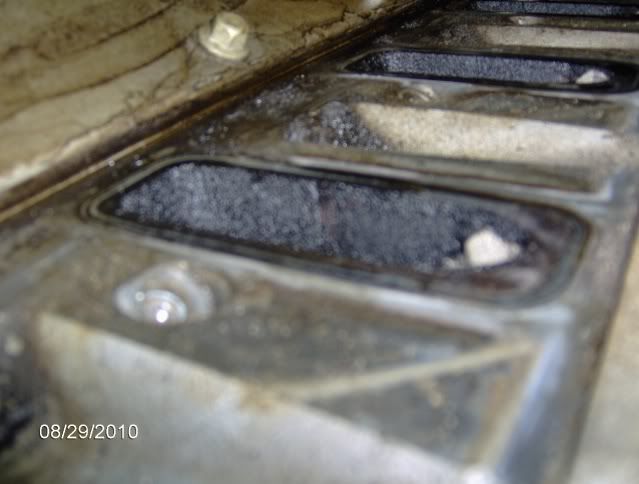
The RX can is the only unit available that has integrated positive closing poly check valves & self regulates the amount of flow eliminating oil pull-through during deceleration from WOT runs.
The cans are nearly 1 qt capacity, have a unique disc baffling system and perforated dispersion tube to ensure the vapors not only cool quickly to droplets, but the large separation chamber allows the flow to slow enough for the droplets to fall out of suspension trapping it before the vapors travel a final passes through a separate exit chamber and out the integrated checkvalve.
The dual valve unit is the ONLY one on the market that ensures continuous crankcase evacuation no matter what the operating mode. In boost or not, the dual valve unit detects the moment the intake manifold becomes pressurized closes preventing the boost from pressurizing the crankcase, and opens the valve allowing the FI head unit inlet to provide the vacuum needed for continuous evacuation.
Remote drain tube makes emptying simple & mess free.
Optional breathered oil fill cap with built in oneway check valve.
Available in most popular GM colors or polished aluminum.
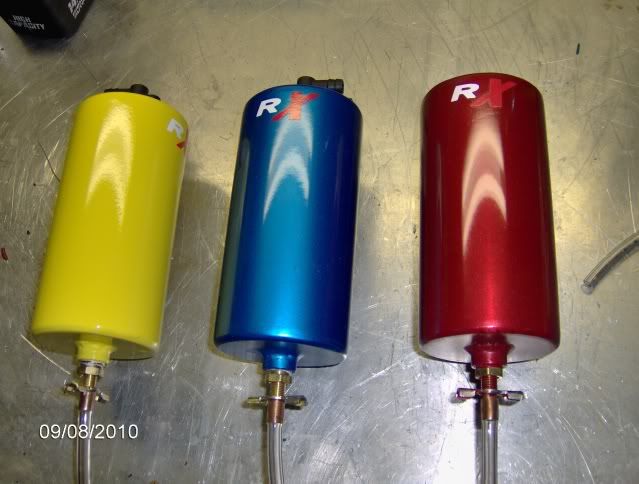


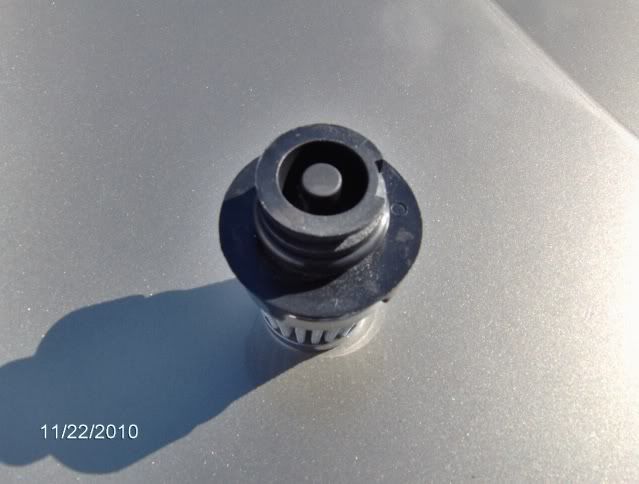
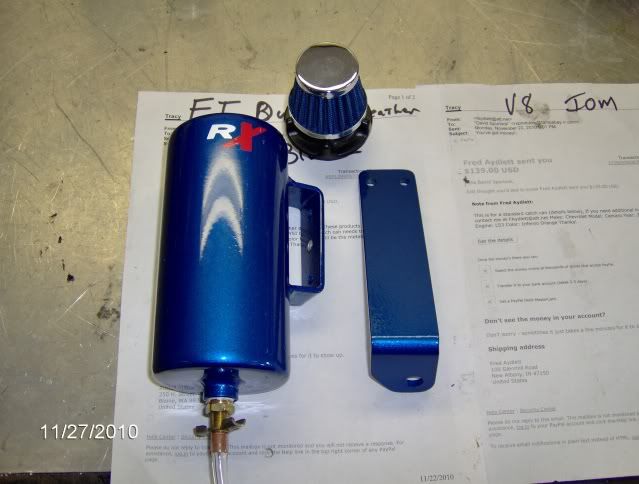
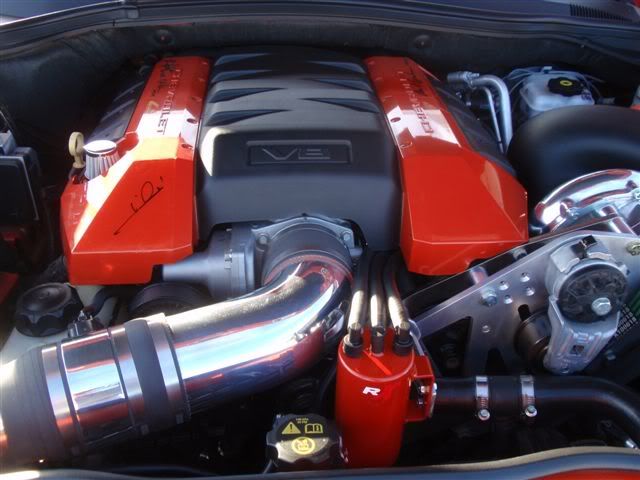
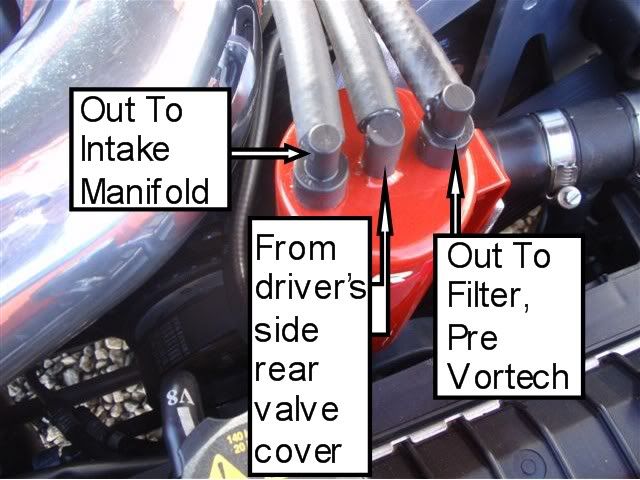
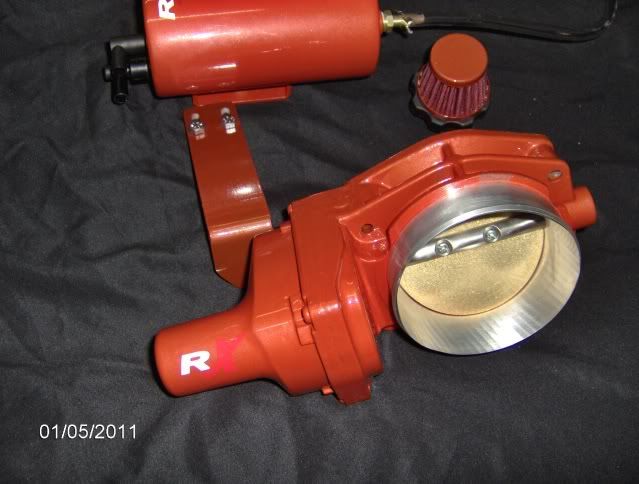
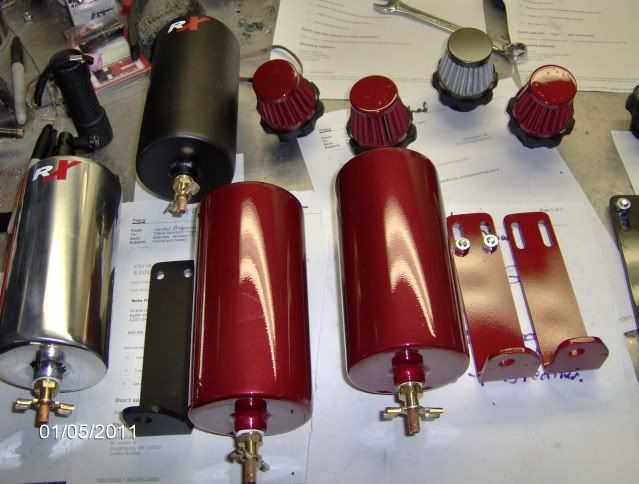
The optional breather has an integrated checkvalve that prevents vapor from escaping into the engine compartment and keeps your system "closed" for emmissions compliance.
PM for any tech or application questions.
a proper PCV oil separating catchcan
Any engine driven hard will ingest a certain amount of oil into the intake air system resulting in loss of power, detonation, and long term carbon buildup on the pistons & valves reducing the velocity and flow through the engine.
Preventing this on a street driven car subject to emissions requires some simple modifications to the closed OEM PCV system.
On all out race applications where emission rules do not apply, this is accomplished in different ways, but proper crankcase ventilation is a must! The crankcase gets filled with harmful combustion byproducts that if not evacuated will cause internal damage to your engine and shorten the usable life. These byproducts include: Sulfuric acids, abrasive carbon particles, unburnt fuel, water, and more. If you do not have a proper crankcase evacuation system these compounds will condense inside the engine and mix with the oil as well as begin corroding internal parts. It is NOT enough to just vent the crankcase pressure through a breather, but it must be flushed with a filtered fresh air source to carry these out & away. In an OEM system, these are burnt in the combustion chamber & further in the catalytic converters.
In an off-road or race application, the engine is normally not used to burn them off.
At the very least drag only motors have a scavenge evac system in the header collectors to pull vac, and anyone that's serious has a belt driven vac pump.....especially the Alky motors due to the amount of moisture the alcohol introduces to the crankcase.
*
Want to see whats in your oil? A simple oil analysis will show you how much harmful stuff ends up in it.
The oil analysis will show the acid build up....and no, it takes a year or two before you would see any substantial damage to your internal engine parts.....but an easy way is after 6 months or so of running like you describe pull a valve cover and look and the corrosion from the vapors on your rocker arms. This is the first place it is visible.
Bottom line is, w/out a proper evac system you WILL sustain long term engine damage. It may take a few years to notice, but I build motors 6 days a week when not racing and see the results first hand.
There are several other ways for oil mist to enter the intake manifold, the PCV system is the most common with the fresh air make up source (the fitting on the top rear of your throttle body) being the second most common. To eliminate that you need to cap the TB fitting and run a valve cover breather (installed as far from the crankcase vent as possible...ideally you want to pull filtered fresh air in one valve cover & evac it out the other or the LS6/LS2 style valley cover is second best) Then if it is excess crankcase pressure pushing oil vapor/mist out faster than the PCV can evac it you will see it pushed back through the line from the pass valve cover front to the TB and it is ingested from there. The 3rd point of ingestion is from reversion. This of course needs at least one piston/ring/bore/valveguide or seal issue that is allowing oil to be pulled into that one or more intake port and at high RPM's the reversion pulse will "push" that oil throughout the entire intake manifold. It will appear to have entered from the vac fitting that the PCV system uses but is really from one of the cylinders (reversion is a whole different process that is not widely understood but do a Google search and you can actually find some super high speed video of engines on dyno's where at high RPM's...9-10-12K plus the reversion cloud of A/F mixture is actually rising out of the intake runners or carb on a non fuel injected motor). To test for that just place a clean clear fuel filter inline between the catch can outlet and the vac fitting. If it gets oil on the can side, oil is coming through the can. If it first appears on the intake vacuum side, then it is reversion so you have a deeper issue.
*
Having engine smoke or excess crankcase pressure? There may be a deeper issue. On the LS motors we pull apart it is usually # 7 ringland broken between the compression & middle ring, or the land itself broke off at the top. We also find the top ringland pinched or crushed down on the top ring (comp. ring) and metal transfer along the piston side has caused the oil & scraper ring to stick allowing oil & blow-by. Also, try this: at idle (vac is at it's greatest when at idle or when the throttle blade closes from high RPM's) remove the oil fill cap and hold your hand over it. Does it pull a slight suction? If so, all is good with most of the system and I doubt you have a damaged piston/ring/bore. But if there is ANY pressure pushing back you have a deeper issue and that is the cause of the oil problem.
Now on big cam/stroker builds a can inline on the dirty side, and a can inline from the fresh air source may be needed (the bigger the bore & longer the stroke, the more crankcase pressure is built up) If it is forced induction, then you have a whole new process to deal with......and that is the PCV system works properly when at idle & non-boost, but when you start making boost you have switched from the intake manifold being negative atmosphere to a pressurized component and the PCV system is rendered useless and pressure escapes wherever it can. The solution then is to have one way check valves inline so the vacuum need for proper evacuation comes from in front of the compressor (head unit) through a line run to the air filter.
This is getting a bit long and I hope all can follow this, but if not ask me specific questions for clarification so this helps all. I'll go over every type of solution and the pros & cons of each....and remember, this problem is NOT just in the GM LS based engines, but is an issue with ALL modern closed systems. We just tear into our cars where as the Mercedes or Lincoln owner never even realizes there is an issue.
I also wanted to address the water in the oil. You will NOT fill your crankcase up in short order with just breathers. What happens is each time your engine reaches operating temp the unburnt fuel, water vapor, combustion by-products will gas or "flash-off" as vapor. But only the excess crankcase pressure being relieved through the breather will carry any of that out....and without a proper evac system, a good amount remains in the crankcase and re-condenses back to droplets that coat the internal engine parts as your motor cools down and it contaminates the oil. Every time you heat cycle you are adding more contamination and it is not very visible to just "look" at your oil....you need a professional analysis to see just what is accumulating in your oil and how it is breaking down its ability to protect...but the corrosion from the sulfuric acid is also very damaging over time (I'll try to post up some pics of parts showing just this in the near future). Just pull the dipstick on a diesel 20 miles after an oil change...it already "looks" black & dirty, but is still new and providing the proper protection. Sight is deceiving. Oil might look pretty clean or dirty but an analysis report will show destructive levels of contaminants.
And finally, some have gone so far as to cap off the entire system and run an open hose from each valve cover to near the ground. While this will eliminate all oil getting into the intake via the PCV system, the damage done by the hose with the least amount of air moving past it while at speed will suck dirt/sand/dust/water/and who knows what else directly into the motor via that valve cover. It may take some time (depending on how clean the roads you drive on are) but will result in premature engine wear & failure.
The solution for the street crowd is a properly designed, good functioning oil separating catchcan. Many are available on the market, but ONLY one designed with internal baffling and a good distance separating the inlet from the outlet. Many of the cans seen for low prices on Ebay, etc. are great looking, but are nothing but empty cans with two fittings attached. Do your homework & get a full understanding before you make your selection.
Some pictures of the LS based engine and the results of oil ingestion over time:


CLICK >>> RX Performance Single & Dual Valve Oil Catch Cans <<< CLICK
The RX can is the only unit available that has integrated positive closing poly check valves & self regulates the amount of flow eliminating oil pull-through during deceleration from WOT runs.
The cans are nearly 1 qt capacity, have a unique disc baffling system and perforated dispersion tube to ensure the vapors not only cool quickly to droplets, but the large separation chamber allows the flow to slow enough for the droplets to fall out of suspension trapping it before the vapors travel a final passes through a separate exit chamber and out the integrated checkvalve.
The dual valve unit is the ONLY one on the market that ensures continuous crankcase evacuation no matter what the operating mode. In boost or not, the dual valve unit detects the moment the intake manifold becomes pressurized closes preventing the boost from pressurizing the crankcase, and opens the valve allowing the FI head unit inlet to provide the vacuum needed for continuous evacuation.
Remote drain tube makes emptying simple & mess free.
Optional breathered oil fill cap with built in oneway check valve.
Available in most popular GM colors or polished aluminum.









The optional breather has an integrated checkvalve that prevents vapor from escaping into the engine compartment and keeps your system "closed" for emmissions compliance.
PM for any tech or application questions.

#2
Ls7?
#3
With the LS7 you have the dry sump oil resivoir to deal with. This vents directly to the intake air bridge and it is quite common for it to "burp" oil directly into it. Some run 1/2-1 qt low to avoid this. The Byunspeed/RX system eliminates the connection to the air bridge with the optional oil fill breather kit AND a seperate remote breather for the dry sump resivoir. Here are some pics of a C6 Z06 intake:
NOT what you want to see.

NOT what you want to see.
#5
Tech Contributor

Member Since: Dec 1999
Location: Anthony TX
Posts: 32,736
Received 2,180 Likes
on
1,583 Posts
CI 6,7,8,9,11 Vet
St. Jude Donor '08

Nice catch can!
#6
Tech Contributor
OP this is a GREAT POST with a ton of good info. I tried to convince a friend about that open breather and no vacuum on the crankcase is what was causing his oil to start to look milky. I had that for a while with an open breather catch can, then I switched to a proper well designed can and all is well.
Last edited by Joe_G; 03-06-2011 at 07:56 AM.
#8
Tech Contributor
Might have to do with what you do with your car. I used to road course and it seems that gets a lot of oil flowing to the intake because of the high vacuum when you are in a lower gear engine braking entering a turn.
#10
Instructor


Can oil ingestion be related to the diesel-like sound I get when the motor is cold? I assume this is piston slap. I ask because the sound went away for awhile after a BG-44k treatment. The noise eventually came back and my assumption is that whatever is causing it is probably there for good even though I now have a catch can.
#11
Any oil ingestion in the intake air charge will cause detonation to an extent, but the genIII & genIV motors all have knock sensors that detect and pull timing before most ears can hear it. The sound of detonation is like "marbles in a can". Unless a tuner desensitized them or the amount that is pulled and the time before it is put back you should not detect any sounds from it, just less power & poor fuel economy.
The piston slap issue has been around since 97 when the first genIII was released in the C5 corvette and although it is not as prevelant as it once was, it is still audible when cold in most motors.
So I cant say that it will help your issue as it may be deeper. It goes away when warm?
The piston slap issue has been around since 97 when the first genIII was released in the C5 corvette and although it is not as prevelant as it once was, it is still audible when cold in most motors.
So I cant say that it will help your issue as it may be deeper. It goes away when warm?
#12
Instructor


Yes, sir - it goes away when the oil temp gets up over ~100. I use the car for autocross & road courses and get lots of oil in the catch can. I had about 30k miles before I installed it though. If there's any erosion it's probably already there!
#13
Understanding the need for
a proper PCV oil separating catchcan
Any engine driven hard will ingest a certain amount of oil into the intake air system resulting in loss of power, detonation, and long term carbon buildup on the pistons & valves reducing the velocity and flow through the engine.
Preventing this on a street driven car subject to emissions requires some simple modifications to the closed OEM PCV system.
On all out race applications where emission rules do not apply, this is accomplished in different ways, but proper crankcase ventilation is a must! The crankcase gets filled with harmful combustion byproducts that if not evacuated will cause internal damage to your engine and shorten the usable life. These byproducts include: Sulfuric acids, abrasive carbon particles, unburnt fuel, water, and more. If you do not have a proper crankcase evacuation system these compounds will condense inside the engine and mix with the oil as well as begin corroding internal parts. It is NOT enough to just vent the crankcase pressure through a breather, but it must be flushed with a filtered fresh air source to carry these out & away. In an OEM system, these are burnt in the combustion chamber & further in the catalytic converters.
In an off-road or race application, the engine is normally not used to burn them off.
At the very least drag only motors have a scavenge evac system in the header collectors to pull vac, and anyone that's serious has a belt driven vac pump.....especially the Alky motors due to the amount of moisture the alcohol introduces to the crankcase.
*
Want to see whats in your oil? A simple oil analysis will show you how much harmful stuff ends up in it.
The oil analysis will show the acid build up....and no, it takes a year or two before you would see any substantial damage to your internal engine parts.....but an easy way is after 6 months or so of running like you describe pull a valve cover and look and the corrosion from the vapors on your rocker arms. This is the first place it is visible.
Bottom line is, w/out a proper evac system you WILL sustain long term engine damage. It may take a few years to notice, but I build motors 6 days a week when not racing and see the results first hand.
There are several other ways for oil mist to enter the intake manifold, the PCV system is the most common with the fresh air make up source (the fitting on the top rear of your throttle body) being the second most common. To eliminate that you need to cap the TB fitting and run a valve cover breather (installed as far from the crankcase vent as possible...ideally you want to pull filtered fresh air in one valve cover & evac it out the other or the LS6/LS2 style valley cover is second best) Then if it is excess crankcase pressure pushing oil vapor/mist out faster than the PCV can evac it you will see it pushed back through the line from the pass valve cover front to the TB and it is ingested from there. The 3rd point of ingestion is from reversion. This of course needs at least one piston/ring/bore/valveguide or seal issue that is allowing oil to be pulled into that one or more intake port and at high RPM's the reversion pulse will "push" that oil throughout the entire intake manifold. It will appear to have entered from the vac fitting that the PCV system uses but is really from one of the cylinders (reversion is a whole different process that is not widely understood but do a Google search and you can actually find some super high speed video of engines on dyno's where at high RPM's...9-10-12K plus the reversion cloud of A/F mixture is actually rising out of the intake runners or carb on a non fuel injected motor). To test for that just place a clean clear fuel filter inline between the catch can outlet and the vac fitting. If it gets oil on the can side, oil is coming through the can. If it first appears on the intake vacuum side, then it is reversion so you have a deeper issue.
*
Having engine smoke or excess crankcase pressure? There may be a deeper issue. On the LS motors we pull apart it is usually # 7 ringland broken between the compression & middle ring, or the land itself broke off at the top. We also find the top ringland pinched or crushed down on the top ring (comp. ring) and metal transfer along the piston side has caused the oil & scraper ring to stick allowing oil & blow-by. Also, try this: at idle (vac is at it's greatest when at idle or when the throttle blade closes from high RPM's) remove the oil fill cap and hold your hand over it. Does it pull a slight suction? If so, all is good with most of the system and I doubt you have a damaged piston/ring/bore. But if there is ANY pressure pushing back you have a deeper issue and that is the cause of the oil problem.
Now on big cam/stroker builds a can inline on the dirty side, and a can inline from the fresh air source may be needed (the bigger the bore & longer the stroke, the more crankcase pressure is built up) If it is forced induction, then you have a whole new process to deal with......and that is the PCV system works properly when at idle & non-boost, but when you start making boost you have switched from the intake manifold being negative atmosphere to a pressurized component and the PCV system is rendered useless and pressure escapes wherever it can. The solution then is to have one way check valves inline so the vacuum need for proper evacuation comes from in front of the compressor (head unit) through a line run to the air filter.
This is getting a bit long and I hope all can follow this, but if not ask me specific questions for clarification so this helps all. I'll go over every type of solution and the pros & cons of each....and remember, this problem is NOT just in the GM LS based engines, but is an issue with ALL modern closed systems. We just tear into our cars where as the Mercedes or Lincoln owner never even realizes there is an issue.
I also wanted to address the water in the oil. You will NOT fill your crankcase up in short order with just breathers. What happens is each time your engine reaches operating temp the unburnt fuel, water vapor, combustion by-products will gas or "flash-off" as vapor. But only the excess crankcase pressure being relieved through the breather will carry any of that out....and without a proper evac system, a good amount remains in the crankcase and re-condenses back to droplets that coat the internal engine parts as your motor cools down and it contaminates the oil. Every time you heat cycle you are adding more contamination and it is not very visible to just "look" at your oil....you need a professional analysis to see just what is accumulating in your oil and how it is breaking down its ability to protect...but the corrosion from the sulfuric acid is also very damaging over time (I'll try to post up some pics of parts showing just this in the near future). Just pull the dipstick on a diesel 20 miles after an oil change...it already "looks" black & dirty, but is still new and providing the proper protection. Sight is deceiving. Oil might look pretty clean or dirty but an analysis report will show destructive levels of contaminants.
And finally, some have gone so far as to cap off the entire system and run an open hose from each valve cover to near the ground. While this will eliminate all oil getting into the intake via the PCV system, the damage done by the hose with the least amount of air moving past it while at speed will suck dirt/sand/dust/water/and who knows what else directly into the motor via that valve cover. It may take some time (depending on how clean the roads you drive on are) but will result in premature engine wear & failure.
The solution for the street crowd is a properly designed, good functioning oil separating catchcan. Many are available on the market, but ONLY one designed with internal baffling and a good distance separating the inlet from the outlet. Many of the cans seen for low prices on Ebay, etc. are great looking, but are nothing but empty cans with two fittings attached. Do your homework & get a full understanding before you make your selection.
Some pictures of the LS based engine and the results of oil ingestion over time:


The RX can is the only unit available that has integrated positive closing poly check valves & self regulates the amount of flow eliminating oil pull-through during deceleration from WOT runs.
The cans are nearly 1 qt capacity, have a unique disc baffling system and perforated dispersion tube to ensure the vapors not only cool quickly to droplets, but the large separation chamber allows the flow to slow enough for the droplets to fall out of suspension trapping it before the vapors travel a final passes through a separate exit chamber and out the integrated checkvalve.
The dual valve unit is the ONLY one on the market that ensures continuous crankcase evacuation no matter what the operating mode. In boost or not, the dual valve unit detects the moment the intake manifold becomes pressurized closes preventing the boost from pressurizing the crankcase, and opens the valve allowing the FI head unit inlet to provide the vacuum needed for continuous evacuation.
Remote drain tube makes emptying simple & mess free.
Optional breathered oil fill cap with built in oneway check valve.
Available in most popular GM colors or polished aluminum.









The optional breather has an integrated checkvalve that prevents vapor from escaping into the engine compartment and keeps your system "closed" for emmissions compliance.
PM for any tech or application questions.
a proper PCV oil separating catchcan
Any engine driven hard will ingest a certain amount of oil into the intake air system resulting in loss of power, detonation, and long term carbon buildup on the pistons & valves reducing the velocity and flow through the engine.
Preventing this on a street driven car subject to emissions requires some simple modifications to the closed OEM PCV system.
On all out race applications where emission rules do not apply, this is accomplished in different ways, but proper crankcase ventilation is a must! The crankcase gets filled with harmful combustion byproducts that if not evacuated will cause internal damage to your engine and shorten the usable life. These byproducts include: Sulfuric acids, abrasive carbon particles, unburnt fuel, water, and more. If you do not have a proper crankcase evacuation system these compounds will condense inside the engine and mix with the oil as well as begin corroding internal parts. It is NOT enough to just vent the crankcase pressure through a breather, but it must be flushed with a filtered fresh air source to carry these out & away. In an OEM system, these are burnt in the combustion chamber & further in the catalytic converters.
In an off-road or race application, the engine is normally not used to burn them off.
At the very least drag only motors have a scavenge evac system in the header collectors to pull vac, and anyone that's serious has a belt driven vac pump.....especially the Alky motors due to the amount of moisture the alcohol introduces to the crankcase.
*
Want to see whats in your oil? A simple oil analysis will show you how much harmful stuff ends up in it.
The oil analysis will show the acid build up....and no, it takes a year or two before you would see any substantial damage to your internal engine parts.....but an easy way is after 6 months or so of running like you describe pull a valve cover and look and the corrosion from the vapors on your rocker arms. This is the first place it is visible.
Bottom line is, w/out a proper evac system you WILL sustain long term engine damage. It may take a few years to notice, but I build motors 6 days a week when not racing and see the results first hand.
There are several other ways for oil mist to enter the intake manifold, the PCV system is the most common with the fresh air make up source (the fitting on the top rear of your throttle body) being the second most common. To eliminate that you need to cap the TB fitting and run a valve cover breather (installed as far from the crankcase vent as possible...ideally you want to pull filtered fresh air in one valve cover & evac it out the other or the LS6/LS2 style valley cover is second best) Then if it is excess crankcase pressure pushing oil vapor/mist out faster than the PCV can evac it you will see it pushed back through the line from the pass valve cover front to the TB and it is ingested from there. The 3rd point of ingestion is from reversion. This of course needs at least one piston/ring/bore/valveguide or seal issue that is allowing oil to be pulled into that one or more intake port and at high RPM's the reversion pulse will "push" that oil throughout the entire intake manifold. It will appear to have entered from the vac fitting that the PCV system uses but is really from one of the cylinders (reversion is a whole different process that is not widely understood but do a Google search and you can actually find some super high speed video of engines on dyno's where at high RPM's...9-10-12K plus the reversion cloud of A/F mixture is actually rising out of the intake runners or carb on a non fuel injected motor). To test for that just place a clean clear fuel filter inline between the catch can outlet and the vac fitting. If it gets oil on the can side, oil is coming through the can. If it first appears on the intake vacuum side, then it is reversion so you have a deeper issue.
*
Having engine smoke or excess crankcase pressure? There may be a deeper issue. On the LS motors we pull apart it is usually # 7 ringland broken between the compression & middle ring, or the land itself broke off at the top. We also find the top ringland pinched or crushed down on the top ring (comp. ring) and metal transfer along the piston side has caused the oil & scraper ring to stick allowing oil & blow-by. Also, try this: at idle (vac is at it's greatest when at idle or when the throttle blade closes from high RPM's) remove the oil fill cap and hold your hand over it. Does it pull a slight suction? If so, all is good with most of the system and I doubt you have a damaged piston/ring/bore. But if there is ANY pressure pushing back you have a deeper issue and that is the cause of the oil problem.
Now on big cam/stroker builds a can inline on the dirty side, and a can inline from the fresh air source may be needed (the bigger the bore & longer the stroke, the more crankcase pressure is built up) If it is forced induction, then you have a whole new process to deal with......and that is the PCV system works properly when at idle & non-boost, but when you start making boost you have switched from the intake manifold being negative atmosphere to a pressurized component and the PCV system is rendered useless and pressure escapes wherever it can. The solution then is to have one way check valves inline so the vacuum need for proper evacuation comes from in front of the compressor (head unit) through a line run to the air filter.
This is getting a bit long and I hope all can follow this, but if not ask me specific questions for clarification so this helps all. I'll go over every type of solution and the pros & cons of each....and remember, this problem is NOT just in the GM LS based engines, but is an issue with ALL modern closed systems. We just tear into our cars where as the Mercedes or Lincoln owner never even realizes there is an issue.
I also wanted to address the water in the oil. You will NOT fill your crankcase up in short order with just breathers. What happens is each time your engine reaches operating temp the unburnt fuel, water vapor, combustion by-products will gas or "flash-off" as vapor. But only the excess crankcase pressure being relieved through the breather will carry any of that out....and without a proper evac system, a good amount remains in the crankcase and re-condenses back to droplets that coat the internal engine parts as your motor cools down and it contaminates the oil. Every time you heat cycle you are adding more contamination and it is not very visible to just "look" at your oil....you need a professional analysis to see just what is accumulating in your oil and how it is breaking down its ability to protect...but the corrosion from the sulfuric acid is also very damaging over time (I'll try to post up some pics of parts showing just this in the near future). Just pull the dipstick on a diesel 20 miles after an oil change...it already "looks" black & dirty, but is still new and providing the proper protection. Sight is deceiving. Oil might look pretty clean or dirty but an analysis report will show destructive levels of contaminants.
And finally, some have gone so far as to cap off the entire system and run an open hose from each valve cover to near the ground. While this will eliminate all oil getting into the intake via the PCV system, the damage done by the hose with the least amount of air moving past it while at speed will suck dirt/sand/dust/water/and who knows what else directly into the motor via that valve cover. It may take some time (depending on how clean the roads you drive on are) but will result in premature engine wear & failure.
The solution for the street crowd is a properly designed, good functioning oil separating catchcan. Many are available on the market, but ONLY one designed with internal baffling and a good distance separating the inlet from the outlet. Many of the cans seen for low prices on Ebay, etc. are great looking, but are nothing but empty cans with two fittings attached. Do your homework & get a full understanding before you make your selection.
Some pictures of the LS based engine and the results of oil ingestion over time:


CLICK >>> RX Performance Single & Dual Valve Oil Catch Cans <<< CLICK
The RX can is the only unit available that has integrated positive closing poly check valves & self regulates the amount of flow eliminating oil pull-through during deceleration from WOT runs.
The cans are nearly 1 qt capacity, have a unique disc baffling system and perforated dispersion tube to ensure the vapors not only cool quickly to droplets, but the large separation chamber allows the flow to slow enough for the droplets to fall out of suspension trapping it before the vapors travel a final passes through a separate exit chamber and out the integrated checkvalve.
The dual valve unit is the ONLY one on the market that ensures continuous crankcase evacuation no matter what the operating mode. In boost or not, the dual valve unit detects the moment the intake manifold becomes pressurized closes preventing the boost from pressurizing the crankcase, and opens the valve allowing the FI head unit inlet to provide the vacuum needed for continuous evacuation.
Remote drain tube makes emptying simple & mess free.
Optional breathered oil fill cap with built in oneway check valve.
Available in most popular GM colors or polished aluminum.









The optional breather has an integrated checkvalve that prevents vapor from escaping into the engine compartment and keeps your system "closed" for emmissions compliance.
PM for any tech or application questions.

"The solution for the street crowd is a properly designed, good functioning oil separating catchcan. Many are available on the market, but ONLY one designed with internal baffling and a good distance separating the inlet from the outlet. Many of the cans seen for low prices on Ebay, etc. are great looking, but are nothing but empty cans with two fittings attached. Do your homework & get a full understanding before you make your selection."
My 08 Vette is street driven and would like to know where it would mount, what plumbing has got to happen and...do you offer a turn key package and pricing of course

#18
Le Mans Master


I'm a little confused. Which unit would you need if an LS7? Dual valve or single valve? Not sure I understand the difference, or is the dual valve for boosted engines? My engine is stock. Also, you mention two optional breathers for the LS7. If one replaces the oil fill cap on the resevour, where does the other one go?
#19
I'm a little confused. Which unit would you need if an LS7? Dual valve or single valve? Not sure I understand the difference, or is the dual valve for boosted engines? The single valve is for NA and top mount supercharger applications. The dual valve is for turbo or front mount superchargers.
For the non-Z06 motors the breather kit replaces the stock oil fill cap. For the Zo6 it is a remot mount breather that replaces the line going from the oil tank to the air bridge. You cap off the airbridge side and then a 3' hose connects to the tank side with the breather mounted near the pass side radiator end
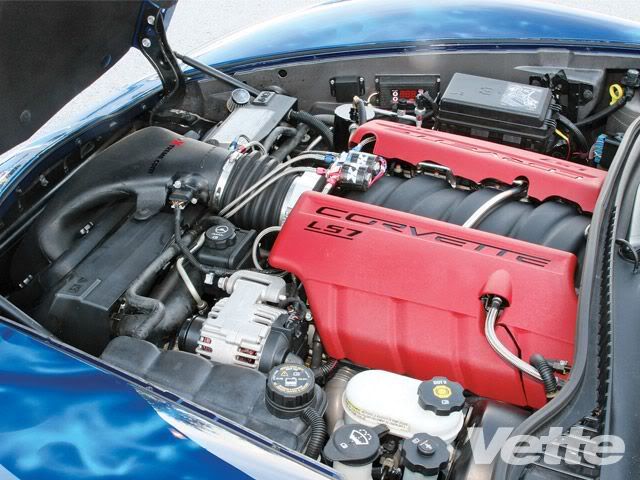
My engine is stock. Also, you mention two optional breathers for the LS7. If one replaces the oil fill cap on the resevour, where does the other one go?
For the non-Z06 motors the breather kit replaces the stock oil fill cap. For the Zo6 it is a remot mount breather that replaces the line going from the oil tank to the air bridge. You cap off the airbridge side and then a 3' hose connects to the tank side with the breather mounted near the pass side radiator end

My engine is stock. Also, you mention two optional breathers for the LS7. If one replaces the oil fill cap on the resevour, where does the other one go?

#20
Instructor


Actually I think that breather would fail a visual smog inspection here in CA, "closed" or not...






